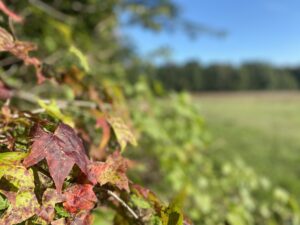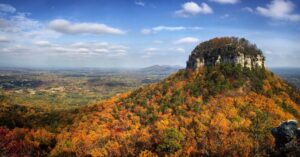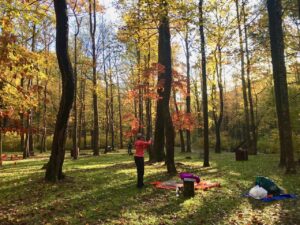Not only are we setting up for a colorful fall, we’re getting it early. After several years of mostly mediocre fall color, the stars — actually, the temperature and the sun — have aligned for what already looks like a great fall color show.
Good fall color depends on several factors, the key ones occurring in September and including:
- Warm (but not hot), days
- Lots of sunshine
- Cool nights
For the past three weeks, we’ve had it all. And at the right time.
As expected, fall color is in full bloom in the highest of the high country. ExploreAsheville.com reports there’s good color as low as the Rough Ridge area on Grandfather Mountain along the Blue Ridge Parkway, at about 4,300 feet. The best color is currently above about 5,000 feet, in the Graveyard Fields area along the Parkway, for instance.
Early arrival in the Piedmont

In the Piedmont, we’re already seeing early and vivid color. The best places to find this early color include:
- Along lake shorelines. Perhaps part of the reason lake shorelines are ideal for catching early color is because they’re exposed; thus, you can typically see more trees to begin with. Being near water also accelerates the process.
- Along rivers. Same as with lakes, though the exposure isn’t as pronounced, which doesn’t seem to matter. Even along small creeks and streams exhibit stellar early season color.
- Edge forests. Where meadow or fallow field meets forest is where you’ll find the best color away from water.
- Vistas. These are hard to come by in the Piedmont: Occoneechee Mountain State Natural Area and Raven Rock State Park are the only two that immediately come to mind. Powerline clearcuts can also provide long views from on high.
We’re hesitant to give specific locations of where to go to catch fall color: Suggest a “secret” place and suddenly it’s not so secret anymore. However, we can make some less-specific, but still hopefully helpful recommendations:
-

Colorful Pilot Mountain anchors the west end of the Sauratown Trail Triangle: Mountains-to-Sea Trail/Falls Lake Trail, 60 miles. Is there a better way to check out fall than on a 60-mile-long hiking trail that hugs a shoreline most of the way? From the Penny’s Bend Nature Preserve in Durham County to the Falls Lake dam in Wake County it’s possible to hike non-stop on the Moutains-to-Sea Trail. For shorter excursions, the trail is broken down into 24 day-hikeable sections ranging from less than a mile tonally 7 miles in length. The Falls Lake MST ducks in and out of coves along the lake, briefly brushing backyards in spots, and escaping civilization entirely in others. Learn more about this section of the MST here.
- Greensboro: watershed lakes, 42 miles (short hikes of as little as a mile). Triad residents have numerous good options around the three watershed lakes — Brandt, Townsend and Higgins — north of town. Forty-two miles of watershed hiking trails take you through a variety of environments. The 1.6-mile Palmetto Trail, for instance, features some interesting geology; the 3.6-mile Nat Greene Trail offers a smorgasbord of Piedmont ecology. Details here.
- Triad: Sauratown Trail, linking Pilot Mountain with Hanging Rock north of the Triad, 35 miles. A total of 35 miles make up this trail network that was designed primarily with equestrians in mind, but the actual link between the Tories Den portion of Hanging Rock State Park and the Surry Line parking area of Pilot Mountain is 21.7 miles, making for a nice, long day hike, if you choose. The advantage to Sauratown is that it takes in some of the same scenery as Hanging Rock and Pilot Mountain (though, granted, without the aerie vistas), but with a fraction of the people. Plan your trip through the helpful Sauratown Trails Association website.
Meanwhile, in Virginia

Virginia has a fall foliage hotline — 800.424.5683 — that you can call for the latest breaking fall color news. For the most part, the chromatic change begins at the highest elevations and cascades downhill. In North Carolina, that means you might head first to Mount Mitchell (6,684 feet) or Clingman’s Dome (41 feet shorter, at 6,643 feet), and in Virginia, to Mount Rogers (5,729 feet). More northerly locations, with generally cooler temperatures, can also see earlier color. The various microclimates that exist in the rugged Southern Appalachians can also affect when fall color will appear. Thus, you can’t go by elevation alone, and this hotline can fill you in on the latest.
The Virginia Department of Forestry is also a good source for fall foliage information, pointing you to great places to catch fall color, describing which leaves turn which colors, even why they turn color in the first place — just about everything you need to know. Find it here.
The Virginia Department of Forestry adds that, typically, the color changes in the mountains from Oct. 10-20, in central Virginia Oct. 15-25 and in eastern Virginia Oct. 20-31.
Regardless of elevation, you’re bound to find some good color this weekend.
GetHiking! with Co-workers and Friends
Speaking of this incredible fall weather and the resulting color, wouldn’t it be great to have your own, personal hiking group — with friends or coworkers — that got together and hiked once a week? A hike that lasts an hour or so, is geared toward your group’s ability, that’s near where you live and that’s planned and led for you? That’s our GetHiking! with Co-workers and Friends hiking program! Learn more about the program and how you can get started with a group of up to 10 co-workers or friends, here.
